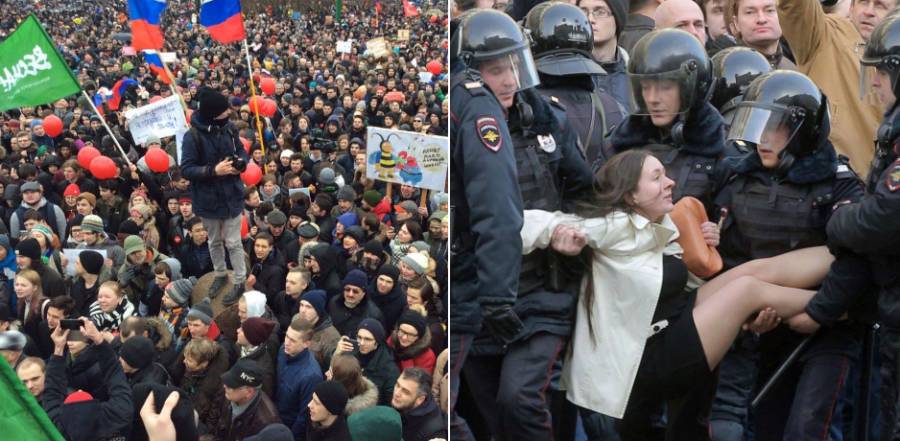Russian state TV in absurd denial over thousand-strong protests, mass arrests

State-controlled media in Russia proved considerably easier to control than ordinary citizens on March 26. Tens of thousands of Russians joined the anti-corruption protests called by Alexei Navalny, despite the likelihood of arrests and gratuitous violence from OMON riot police and Russian President Vladimir Putin’s own ‘National guard’ [Rosgvardiya]. Many hundreds were reported detained in Moscow and St Petersburg alone. At least one activist – Dmitry Kiselev – was arrested in Russian-occupied Crimea and is reported to have already been jailed for 10 days. All of this, and the arrest of Alexei Navalny, was either muffled by state-controlled television channels or distorted. The lies may work in parts of the country where people have no other source of information, but were especially absurd given the amount of video footage posted on social networks and Twitter and the breaking news headlines in the international press. In Samara, those detained included any protesters streaming the events onto the Internet. The person who announced the planned protest, Sergei Ryzhov, has totally disappeared after being taken away by police.
The protests were called by Navalny and followed his release of a film, which can be seen here, allegedly of vast amounts of property and wealth amassed by Prime Minister Dmitry Medvedev. It was the latter’s resignation that the protesters were officially demanding. In fact, few see the corruption rampant in Russia and other problems as the fault of Medvedev alone and many of the banners were opposed to the Putin regime altogether.
A very small part of the over 90 demonstrations planned around the Russian Federation received ‘permission’ from the authorities. This meant that for the riot police it was enough that protesters on the ‘unauthorized’ demonstrations were holding a placard or chanting a slogan to get them taken, dragged or even carried off to police stations. In Moscow, Navalny was detained together with hundreds of others.
For obvious reasons, it is extremely difficult to know the real number of detentions. It was probably no accident that, at least in Ukraine, the OVD.info site which monitors illegal arrests, etc. was down until well into Sunday night. This was invariably the case for many Ukrainian human rights sites, including KHPG, during earlier anti-government protests and during Euromaidan.
In Moscow, OVD.info reports that 860 people were detained, including at least 10 school students or other minors. The police had worked together with Rosgvardiya, which was created by presidential decree in April 2016, and was from the outset widely viewed Putin’s own “personal army” aimed at quelling unrest.
Since the Moscow authorities had refused to authorize a peaceful protest, the right to which is guaranteed by Russia’s Constitution, Navalny called on people to go on ‘walks’ through the same streets. Police vans were waiting from the morning, and a helicopter flying overhead.
The first people were reported detained an hour before the ‘walks’ were due to begin. Grani.ru’s correspondent reported that the absence of any placard did not stop the police from descending on people and dragging them away.
The police claimed there were 7-8 thousand people at ‘an unauthorized meeting’, while Grani.ru believes the number was much higher, around 20 thousand.
Open Russia reports, citing parents of the victim, that a young British school student was grabbed by police as he came out of Belorusskaya metro and beaten, after he disagreed with the police that he was obliged to have his documents on him. His parents are preparing a formal complaint.
Navalny was detained soon after 14.00, with others trying to prevent the detention and one protester being hit on the head by a police helmet. His press secretary later informed that he is being charged with organizing something called “a mass simultaneous presence of citizens’. He spent the night in custody with a court hearing due on Monday morning.
Grani.ru asserts that the police beat demonstrators while detaining them on Pushkin Square, and also used teargas against them.
Many of the reports, and the video footage from other cities as well, such as Khabarovsk, show protesters beaten and treated extremely roughly.
It is therefore telling that one of the few reports on pro-Kremlin media, from Life News, was about a police officer, allegedly injured by a protester in Moscow, and seemingly guaranteed a full month’s leave to give the Investigative Committee ‘evidence’ for a criminal investigation on charges of “an attempt on the life of a police officer”.
It is interesting also to note the kind of subject matter that Russian-controlled channels opted for to avoid reporting on the thousands protesting (let alone the grounds for their protest). NTV had a long feature on French National Front leader Marine Le Pen, claiming (against more customary sources of such information) that she was now ahead of her main rival after her meeting with Putin in Moscow, as well as some likely defamatory reporting about Denis Voronenkov, the Kremlin critic planning to give testimony vital to Ukraine, who was gunned down in Kyiv last week. Ukraine and its problems, real or invented, were also clear favourites for distracting TV audiences.





